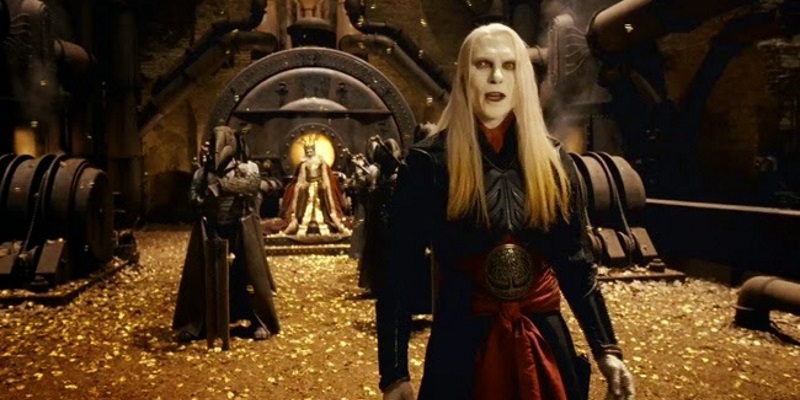The Schemes of the Archfey, Part Three

At last we come to the third part of the Schemes of the Archfey, in which I offer story hooks and political interactions for the archetypes of Archfey (archfeytypes) that I described earlier in this series. This article covers the Mother of Redcaps, the Dream-Tyrant, the Winter Lord, the Muse of Steel, and the Eldest. Particularly with the Eldest, I’ve tossed out story ideas every time I’ve mentioned them, just because I think most DMs will be less familiar with how to use them.
Fey Chivalry | Fey Huntsmen and Leashed Terrors | Faerie Tales: Naiads, Pixies, and Sprites for 5e | A Visit to the Shadowfell – Shadar-Kai & More | In a Goblin Market | Fey of the Elder Starlight | Fey Enchanters and Their Lairs | Treasures of a Fey Market | Archfey Patrons | Archfey Patrons, Part Two |Archfey Patrons, Part Three | The Schemes of the Archfey | The Schemes of the Archfey, Part Two | The Schemes of the Archfey, Part Three
Mother of Redcaps
Coming up with conflict for the Mother of Redcaps is the simplest thing in the world – she and her followers provoke conflict wherever possible. There are only so many times a redcap can saunter up to you and chew your face off before that gets real tedious, though. It’s considerably more challenging to work out deeper goals and interests for what’s usually a pretty straightforward character.
- Like hags of any stripe, the Mother of Redcaps seeks to recover her lost beauty. Maybe she’s a Countess Báthory figure, or maybe she was cursed by the Seelie Queen so that her outward seeming should reflect her inner nature. In theory this is a pretty understandable goal and lends her a bit of pathos, but her murderous approach and our cultural views on vanity undermine that. Whenever the PCs need to recover miraculous healing elixirs, fruit that grows once a century, purest water from a hidden spring, or the like, the Mother of Redcaps is there pursuing the same prize.
- I mentioned before that she’s got a lot in common with a crime boss. Take that to its logical conclusion: redcaps and her blood-cult warlocks keep a frontier town safe from harm, in exchange for blood or pretty people or whatever they’re going to eat that day.
- I may have been listening to a lot of Mike Duncan’s History of Rome podcast, and semi-consciously equating redcaps with Gauls. Apologies to French people, because I realize that blood sausage is common to every part of Europe. At least you aren’t eating the worst pies in London.
- Human cultures have important feast days. I bet the fey do too. What do redcaps do in preparation for Mama’s Birthday Feast or the dreaded Midnight Wassail? What could PCs learn or steal by attending such a revel in disguise, and what do they have to do to avoid winding up as the main course?
Dream-Tyrant
More than anything else, the Dream-Tyrant is about what the protagonist wants, delivered in the worst way possible. You want a night off from babysitting? Take all nights off. All you can really do to protect yourself from the Dream-Tyrant is to always do things the hard way and never let anyone hear you ask for help or a shortcut.
- When I saw this character archetype used in the Atlanta-area LARP Shattered Isles, it was indeed called the Goblin King and, not at all shy about borrowing, he dwelt in a labyrinth, though one more terrifying than whimsical. One of the great Catwoman characters (some days an enemy, some days an ally) of the whole campaign, that character wound up being an incredibly compelling unreliable ally. I only participated in a small portion of that story, so I don’t know all that they did with it. He was neither Seelie nor Unseelie, but a wild card and foil to both Courts.
- In a future article in this series, I’ll discuss alternate Court structures beyond Summer/Winter dualism.
- Since most PCs will be too cagey to get sucked into a deal with any Archfey, much less the Dream-Tyrant, you’ll probably have better luck with giving the PCs a friend who has a spot of bad judgment. Maybe the Dream-Tyrant pays their debts with fools-gold, misleads the long arm of the law (squarely into the PCs, of course), or hides their cheating ways from their romantic partners (leaving each of those romantic partners in a bad situation).
- I can easily see the Dream-Tyrant allying with the Lord of the Hunt, as both thrive on fear and night. Perhaps the Dream-Tyrant is the Good Fellow in disguise – something sinister and cruel seems like the kind of trick Robin Goodfellow would play, without understanding or particularly caring who he hurt. Similarly, I would expect the Dream-Tyrant and the Night Collector to be either the closest of allies or the bitterest of rivals, as their interests are so similar even as their means are not.
Winter Lord
Writing stories around seasonal villains is always hard, in games as in comics. What I think I’d do with the Winter Lord is a bit different: I’d have him use the pre-existing winter to attract new servants and supplicants.
- A region suffering from a particularly severe winter (possibly preceded by a poor harvest) is surprised to see horse-drawn carriages (or sleighs) coming through the snow, bearing unusual-looking people who offer them a fine hot meal and a tot of brandy to aid them in these dark times. Eating the food of Fairyland is great at the time, but once you return to the mortal world, nothing is ever the same…
- Or maybe the food and drink are fine, and this generous lord just wants you to work for your supper. Making toys, perhaps, as you grow ever more wizened over time.
- In this, then, the Winter Lord openly opposes the Green Man. They both want to get paid (in tribute or oaths of service) for relieving starvation – the Green Man before the fact, the Winter Lord after. This might make late summer and autumn a truly vexing time for adventuring, as both exert their power to influence the weather and spread or inhibit blight.
- Claiming existing frozen lands in the Material Plane might be useful to the Winter Lord, as he has to draw less of his power from his holdings in the Feywild. Once the Winter Lord is revealed as a major antagonist, the PCs have to travel to ice caverns, ice floes, and glaciers to deconsecrate the shrines that represent his hold over that territory. Particularly in the ice floes, the Sea Hag is just as likely to be an ally as an adversary.
Muse of Steel
Most of the story ideas that come to me involving the Muse of Steel are revolutionary, setting-altering matters – the invention of the cannon, firearms, or the printing press. The Muse of Steel might reasonably support any of these innovations. On the other hand, if they came from mortal ingenuity rather than fey inspiration, she might oppose them and try to set mortals back on her preferred track.
- In settings that feature both forest gnomes and rock gnomes, the Muse of Steel is a conceptual bridge between the two cultures: fey, as forest gnomes sort of are, but interested in tinkering, machinery, and innovation. Depending on how much of a schism the two subraces represent in your setting, she might be a useful wedge issue or uniting issue.
- In my setting, the Muse of Steel doesn’t concern herself with any of the consequences of her decisions. She didn’t teach the creation of firearms; she just opened the inventor’s mind to what he hadn’t yet realized he already knew. There was a terrible, bloody war. He tried to stop developing new and better firearms. She didn’t like that, and the PCs encountered him in the course of his punishment. Now that they have freed him, though, he’s definitely going back to developing better firearms, to avoid angering her further.
- She has a complicated relationship with the Silver Knight. She makes things that are great at killing monsters, great at defending warriors from harm, and so on. To the Silver Knight, this sounds great… up to a point. Once intellect and preparation outweigh personal valor and sacrifice, though, the relationship either sours, or takes a turn so that the Silver Knight wants his enemies equipped with firearms.
- He watched The Last Samurai a few too many times, but of course he’s immortal…
The Eldest
Once even one of the Eldest is in the world, it should be the kind of problem that reunites the Courts to do something about it. Except that, let’s be real, they don’t stop being treacherous just because they’re in danger, so look for a Xanatos Gambit of some description from the Queen of Air and Darkness. On the other hand, the Eldest were defeated through an alliance of foes once before, and stopping that from happening again is Priority One. What else might the Eldest do with their time?
- They take a shot at an upstart god, against whom they present a credible threat. This gives 20th-level PCs a chance to fight alongside their gods, while still mattering in the fight. It might also include a race against time to find some kind of protection against elder starlight before the showdown.
- With incredible cosmic power at their disposal, they might casually conquer a demiplane or a layer of the Abyss, opening the door to strange bedfellows as the PCs get involved. Sure, you don’t really want to see Azzagrat restored to its former glory, but any action that deposes the Eldest clears the way for Graz’zt to return.
- Even if the PCs aren’t immediately inclined to get enmeshed in this, the Archfey can’t avoid it – they have to have allies against the Eldest, even at the cost of betraying their core principles. This could lead to demonically-empowered fey knights, diabolic fey huntsmen, or ancient chromatic dragons suddenly finding it worthwhile to serve as mounts for the Archfey and their highest-ranked servants. In short, it gives you a chance to shock your players with a radical reorganization of cosmic alliances, and provides a clear bridge into epic-level play.
Next time in this series, I’ll create a variety of fey-themed magic weapons and shields to go with the Treasures of the Fey Market article I wrote some time back. There may also be additional magic armor, depending on what comes to me as I write. Thanks for reading, and I hope you enjoy these story ideas!



